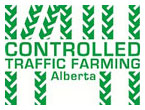Agronomist Notes
Hello Reader
I’m back from my two-week writing break during which very little harvest occurred but a lot of weather happened. Total rain for the 30 days leading up to harvest at our farm reached 10 inches, not to mention the major snowstorm September 8th. The storm affected a 100km2 area or about about 2.5 million acres. Wheat and canola fields were flattened and the ground is still very wet. Most producers resumed harvest on Tuesday.Yields are all over the map but it’s safe to say we’ll have an average year. Feed and malt barley yields are ranging from 85 to 100 bu/ac, wheat between 55-65 bu/ac, peas at 35-55 bu/ac and canola around 35-45 bu/ac. These are very rough numbers given that 90% of the crop still remains in the field.
This week I’ll provide a brief review of a few vertical tillage tools we trialed recently with a client. Next, we’ll look at how we manage residue through tall stubble and crop rotation. Last, I’ve included a cool example of how a canola seed coating with lime led to a huge increase in canola establishment. You may (or may not) notice the absence of the grain market news segment in this newsletter. Thanks to great feedback from subscribers, I’ve bid aideu to the charts and will no longer include them.
Have a great week.

Harvest Progress
(Calgary to Drumheller to Three Hills)Crop Complete
Wheat 5%
Canola 5%
Barley 20%
Peas 95%
Quick evaluation of vertical tillage units
Another year of heavy residue, lodged crops and ruts from harvest traffic has peaked the interest of many to purchase vertical tillage units. I had a chance to watch a demo of three VT units side by side to compare the residue management, field finish and soil disturbance on barley stubble. I looked at the Salford RTS, Horsch Joker and Case TT 330 Turbo. Here are my notes:Test conditions: One pass at 8.5 mph, each tool set to 2.5 inches deep on a moist, sandy loam soil on silage barley residue with some quack grass and lodged areas. I have included the approximate prices of the machines that were in the field.
Click on the name of the VT machine for a link to the specs online.
Salford RTS, $80,000, 31 ft
- Leaves stubble anchored in the soil.
- Leaves 85-90% of residue on the surface or standing.
- This machine is built to cut and size residue, not incorporate.
- The cutting action of the wavy coulters does not work well in dry, hard soil.
- This is not a great tool for leveling ruts or incorporating products into the soil
- This is a residue management machine only.
- Leaves just 50-60% of stubble standing
- The tool is built for working in wet soil.
- There is a lot of soil structure damage with this unit. More than the Salford but less than the Joker.
- Dislodges stubble and turns a lot of soil at 8.5 mph but less than the Horsch Joker.
- This tool does a good job of leveling soil and filling in ruts.
- The tool cuts and sizes residue well but does so at a cost of dislodging stubble.
- Dislodged stubble can create plugging issues with seeding tools in the spring.
- This tool could be used to incorporate products like fertilizer, granular herbicides and lime.
- This is the most aggressive machine of the three and an ideal machine for disking ruts and leveling fields.
- Leaves the least amount of stubble standing at 25-35%. Even the stubble left standing is not well anchored.
- There is a tremendous amount of soil mixing inside the working depth. It buried 5-inch tall residue out of sight.
- The Joker would do work the best for full incorporation of fertilizer or lime or residue.
- The field finish is smooth so likely the most at risk for wind and water erosion. You can manage soil disturbance somewhat through working depth and speed, much like the other VT machines.
In the end, not all vertical till machines are the same. The Salford stands out as a residue management machine. It cuts and sizes residue very well and leaves the stubble anchored. If that’s what you’re looking for then the Salford RTS is a good fit. If you’re looking to cut and size residue, manage some ruts while leaving some stubble anchored, the Case 330 TT would be a good choice. If you’re looking for maximum shallow incorporation, very little stubble anchored, field leveling and fertilizer incorporation then the Horsch Joker is the machine to do it.
My final remark is a warning to never undervalue standing, well-anchored stubble. We have to weigh the benefits of residue management with the drawbacks of soil disturbance in our semi-arid climate. Please do not undo 20 years of no-till. And how about this question: What kind of chopper/spreader modification could you build with $80-$90,000 to manage the residue you can't right now? Could we approach the problem from a different way? SL
Work residue with rotation
As part of our CTF, inter-row seeding system, we enjoy the benefits of seeding into tall stubble. Leaving 12 to 16-inch tall stubble has increased harvest efficiency, improved residue management, improved germination and emergence, and increased moisture use efficiency. That said, you can’t keep tall stubble every year and nor should you. The key to managing tall residue starts with crop rotation. Here’s how we do it:Year 1: Plant wheat and leave stubble 12 to 16 inches tall
Year 2: Plant peas and cut short at 4 to 5 inches tall
Year 3: Plant canola and straight cut high at 12 to 16 inches tall
Year 4: Plant wheat/barley and cut tall as possible
Year 5: Plant faba beans and cut short
In Year 1, leaving tall wheat creates a trellis for the peas to fall on when they lodge, which they usually do. This allows us to cut our peas at 4-5 inches without dropping the header on the ground and the issues that arise from mud and rocks. By harvesting peas at 4-5 inches tall we cut last years wheat stubble down to 4-5 inches. This spreads out the heavy residue load over two years and combines a low volume residue from peas with a higher volume residue like wheat. Also, the low C:N ratio from the peas balances out the high C:N ratio from the wheat which helps residue break down faster. This leaves a low residue environment to plant canola into Year 3 so we have less emergence problems. It also gives us a two-year break from cereals to manage disease.
The key to setting up a uniform plant stand so you can achieve optimal yields starts with proper residue management. By keeping tall stubble when it counts and combining crops with high and low C:N ratios, we can manage our residue load by spreading it out over a number of years. The end result is a healthy plant stand that is not hindered by heavy residue and a rotation that helps speed up the breakdown so it doesn’t hinder us for years to come. SL
A unique seed coating strategy
Improving canola emergence with lime
I was researching seed treatment technology recently and came across a really cool trial on seed coating that significantly helped improve canola germination and emergence. The example comes from Victoria, Australia where canola seed was coated with lime and talcum powder to manage in-furrow acidity. The trial played out like this:Problem: Producer was only able to achieve 30-40% canola emergence, where area average was just 50%. (Sound familiar, Canucks?)
Proposed cause: The ammonium based fertilizer blend created a zone of acidity with a high salt index around the seed creating undue stress on the seed.
Solution: Coated the canola seed with a 5% to 30% lime and talc mix to buffer the seed from acidity caused by the ammonium based fertilizer.
Results: The result was a 67% improvement in hybrid seed emergence and an 83% improvement in TT (triazine tolerant) varieties. This improvement was only seen once the coating level reached 20% or greater with best results at 30% with both lime and talcum powder.
When you look at an average emergence rate of 50% in canola and the big question mark over the toxicity of seed-placed fertilizer, you have to wonder if this technology would fit in Western Canada. It certainly warrants some research. It’s quite common for us to apply ammonium-based fertilizers like urea, MAP and AMS with the seed and we often push the envelope on what's considered safe. Perhaps this technology could help reduce the risk of seedling toxicity from fertilizer or from acid soils in general. Food for thought. SL





